I love making my own homemade herbal bath and beauty products. Making soap was the one thing that I didn’t do for a long time, admittedly because I was scared of the whole process. But when I finally did it, I realized it wasn’t really that bad. Since I’ve started to make soap, I’ve also become interested in making shampoo bars. The process is the same as soap, but with different ingredients that are good for healthy hair. I’m sure you will love these homemade rosemary mint shampoo bars that I’m sharing with you today!
How to Make Rosemary Mint Shampoo Bars
This recipe for rosemary mint shampoo bars comes from Jan Berry’s (of the Nerdy Farm Wife blog) Natural Soap Making eBook package, and she has been so kind to let me to share it with you!
Besides the main book on soap making, she also offers a bundle that includes two companion eBooks: All Natural Milk Soaps and Natural Shampoo Bars. The bundle is so worth it and I’m so glad to have all of these awesome natural soap recipes at my fingertips.
My favorite place for buying carrier oils, essential oils, and dried herbs for soap making is Mountain Rose Herbs.
I get the lye from Essential Depot.
For a more detailed list of equipment, or if you are new to making soap, please see my post on how to make soap for beginners, or get Jan’s Natural Soapmaking eBook package.
It goes into much more detail on the whole process and makes it all really clear for people who are just starting out.
STEP 1
Wearing gloves, goggles & long sleeves, weigh the distilled water into a heatproof pitcher.
Weigh the lye next, then carefully sprinkle and stir it into the water. Set the solution aside in a safe place to cool, while you measure out the oils.
If making hot process soap, the lye solution only needs to cool for around 15 to 20 minutes.
If making cold process soap, let it cool for 30 to 40 minutes first, so the temperature drops to around 100 to 110°F (38 to 43°C).
STEP 2
Weigh and melt the coconut oil, then combine it with the other oils. This should bring the temperature up to somewhere around 90 to 100°F (32 to 38° C).
STEP 3
Pour the lye solution into the oils. Using a combination of hand stirring and a stick (or immersion) blender, mix until trace is reached.
STEP 4
At this point, if making cold process soap, add the essential oils then pour directly into a mold, cover and insulate with a towel or blanket.
Let the soap stay in the mold for 1 to 2 days, then remove from the mold and slice into bars. Cure in the open air for 4 to 6 weeks before use.
If making hot process soap, you’ll need to further cook the soap in your crockpot or slow cooker.
STEP 5
(Hot Process Version Only) Place the raw soap batter in a crockpot or slow cooker turned to low. Cook for 1 hour, stirring every 15 minutes. After the cook time is done, stir in the essential oils, then spoon into a mold. Let rest for 24 hours before cutting.
Hot Process Soap can be used right away, but still benefits from a few weeks of cure time.
The main difference between soap and shampoo bars is that shampoo bars are made with oils that are known for hair care, such as jojoba or argan oil.
There are also herbs, such as the rosemary and mint that are used here, that are great for hair.
There are many more herbs for the hair and scalp that you can read about in the Natural Soap Making eBook. Jan also talks about the importance of using a vinegar rinse with shampoo bars, and has a few great ideas and recipes for those as well.
I think you will love these rosemary mint shampoo bars!
To begin with, they smell absolutely amazing. They are pepperminty in a good way, and also herbaceous and piney from the rosemary. They are great for the hair of course, but you can use them just as regular soap as well.
Natural Soap Making eBook & eCourse
If you are interested in learning more about making soap, Jan has a Natural Soap Making eBook and Soap Making Success eCourse that I highly recommend.
First, it covers the basics of soap making, then over the course of six lessons you’ll learn how to make natural soap successfully with these ingredients and methods:
- Fruits & Veggies
- Flowers & Herbs
- Alternative Liquids
- Natural Colorants
- Simple Soap Designs
- Soap Label Designs
Check out Natural Soap Making and Soapmaking Success to learn how to become more confident and adventurous in your soap making!
I think I’m fully addicted to soap making now. I’ll never buy soap (or shampoo) again!
Have you ever made or used shampoo bars?
Natural Soap Recipes
Once you start making homemade soap, you’ll never be able to go back to store bought bar soap again. Have some fun and try these other soap recipes too!
- Wild Rose & Yarrow Soap
- Kombucha Soap
- Beginners Calendula Soap
- Dandelion Soap
- Winter Spice Pine Soap
- Rose Hip Soap
Rosemary Mint Shampoo Bars
Equipment
Ingredients
Oil Portion
- 10 oz olive oil
- 8 oz coconut oil
- 4 oz sunflower oil
- 4 oz castor oil
- 2 oz jojoba oil
Liquids and Lye
- 3.82 oz lye
- 10 oz distilled water
Essential Oils
- 1 tbsp peppermint essential oil
- 1 tsp rosemary essential oil
Instructions
- Wearing gloves, goggles & long sleeves, weigh the distilled water into a heatproof pitcher. Weigh the lye next, then carefully sprinkle and stir it into the water. Set the solution aside in a safe place to cool, while you measure out the oils.
- If making hot process soap, the lye solution only needs to cool for around 15 to 20 minutes. If making cold process soap, let it cool for 30 to 40 minutes first, so the temperature drops to around 100 to 110°F (38 to 43°C).
- Weigh and melt the coconut oil, then combine it with the other oils. This should bring the temperature up to somewhere around 90 to 100°F (32 to 38° C).
- Pour the lye solution into the oils. Using a combination of hand stirring and a stick (or immersion) blender, mix until trace is reached.
- At this point, if making cold process soap, add the essential oils then pour directly into a mold, cover and insulate with a towel or blanket. Let the soap stay in the mold for 1 to 2 days, then remove from the mold and slice into bars. Cure in the open air for 4 to 6 weeks before use.
- If making hot process soap, you'll need to further cook the soap in your crockpot or slow cooker.
- (Hot Process Version Only) Place the raw soap batter in a crockpot or slow cooker turned to low. Cook for 1 hour, stirring every 15 minutes. After the cook time is done, stir in the essential oils, then spoon into a mold. Let rest for 24 hours before cutting.
- Hot Process Soap can be used right away, but still benefits from a few weeks of cure time.
Notes
- Rosemary essential oil should be avoided if you’re pregnant or have hypertension or epilepsy. In these cases, you can omit it altogether or infuse a portion of your oils with dried rosemary leaf instead.
- This soap can be made using hot process or cold process method.
- If making hot process, use the full amount of water. If making cold process, reduce the water amount to around 8.5 oz (241 g), so it will release from the mold easier.
- Superfat is 5%. For a 6% superfat, use 3.78 oz (107 g) of lye (sodium hydroxide) instead.

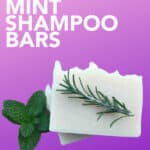
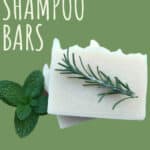
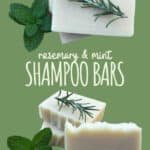
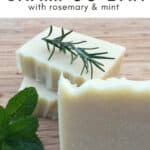
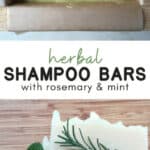
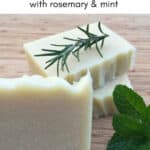

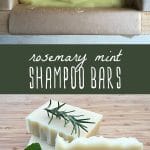
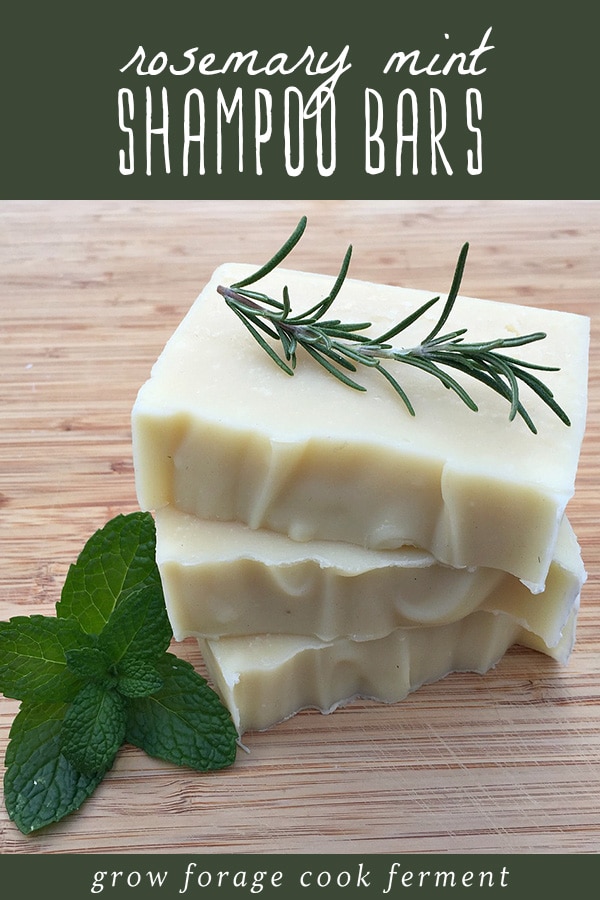
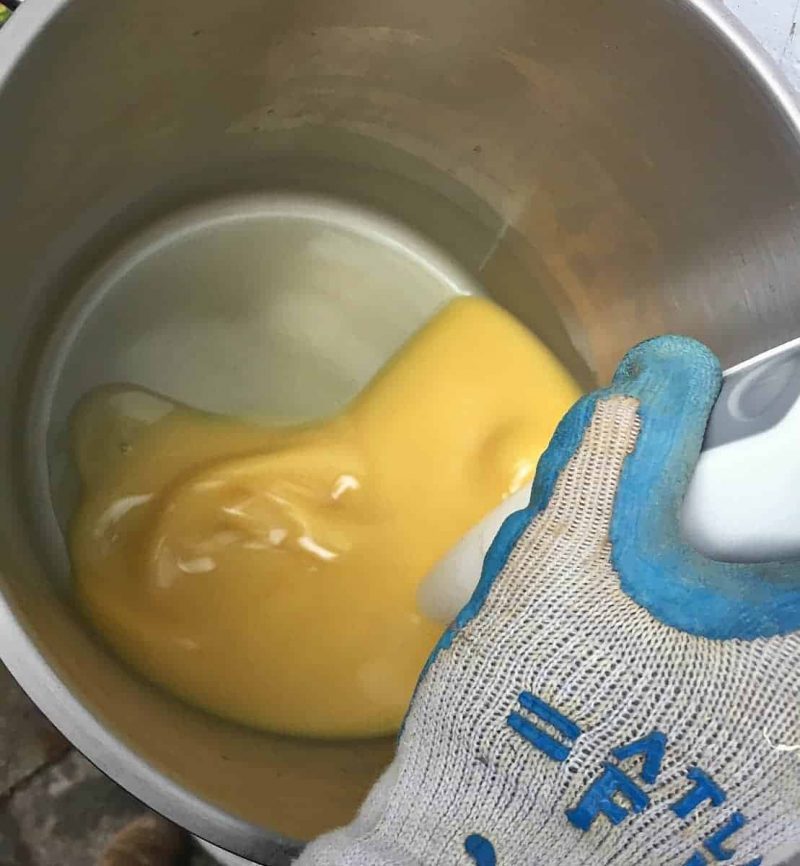
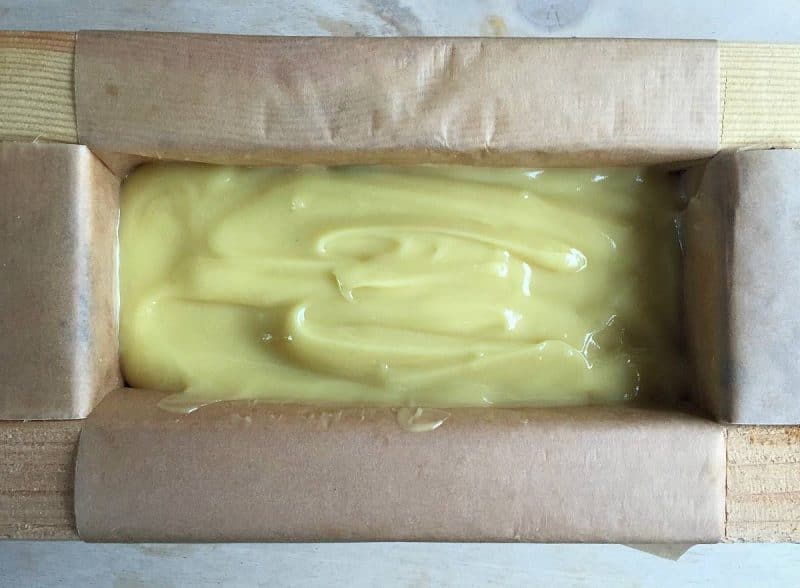
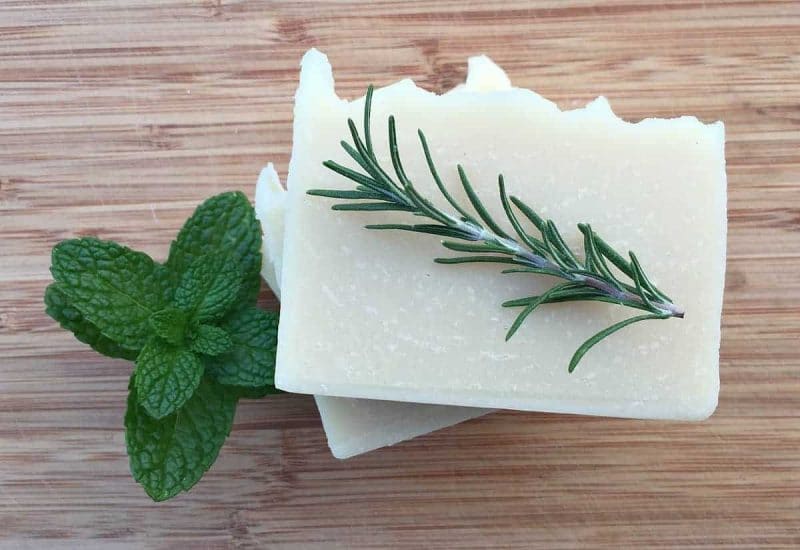
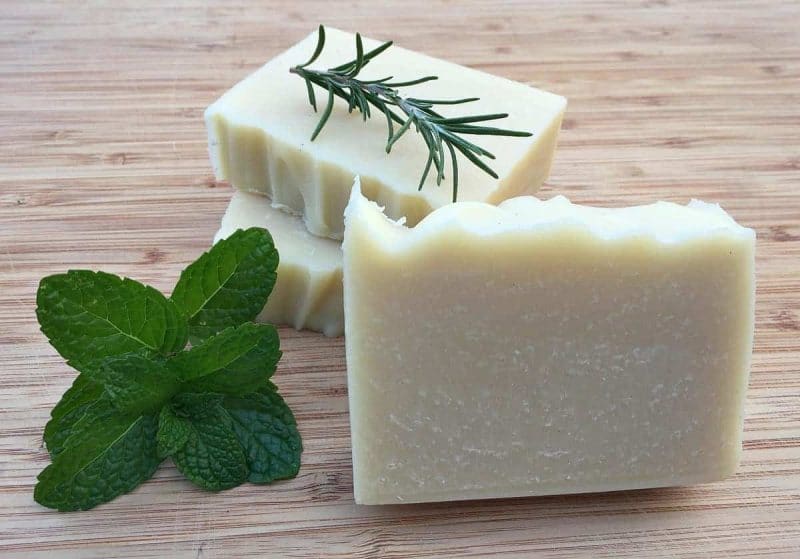
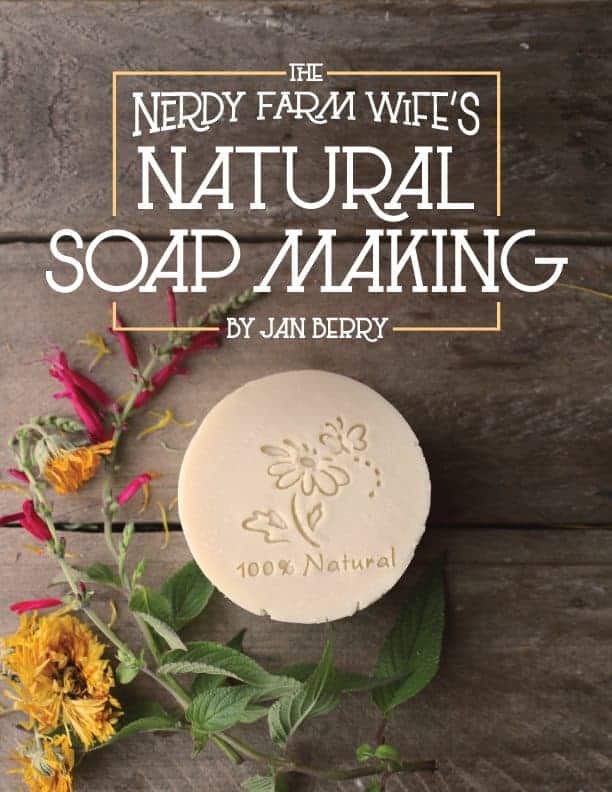
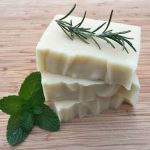

I love these shampoo bars. Is it safe to use the bars with rosemary EO in them when pregnant? If I wanted to make a new batch while pregnant could I just have my husband mix in the EOs and pour it into the mold?
Hi Kris, rosemary essential oil is on the list to avoid while pregnant. While I think it would probably be fine to use on your hair, it’s always best to err on the safe side. I would use different essential oils that are known to be safe during pregnancy, like lavender or sweet orange.
Hi! I love the recipe! I tried it and my soap was pretty green and yours is white. Did I do something wrong? I used lemongrass, but it was already green after I got it to trace. Thank you!
Hi Matt, if the olive oil you used was green in color that could be the reason! Otherwise I’m not sure.
Loved making this recipe and it smells beautiful, but…
*It took ages to harden and is still not completely hard. Should I wait longer until using it? Or would rebatching it help?
*When I’ve used it, my hair feels heavy and greasier than before I washed it. Is this part of the process of changing to shampoo bars? Is it to do with living in hard water area? Is it because I did not have a rinse to balance/remove the grime from my hair?
Any thoughts about what to do would be very much appreciated as I don’t like waste!
It’s a recipe for a soap and the soap is a heavy one at that. You should probably just let it dry for a few weeks and not use it as a shampoo.
I have never made or used this bar, but had a similar experience with a commercially available shampoo bar and quit using it because it made my hair feel so greasy and gross. I ran across a suggestion online several years ago (I don’t even remember where!) that said if you have hard water, wetting your hair with baking soda water prior to using a shampoo bar can be helpful. It made all the difference for me and I have been happily using bar shampoo since.
I have tried various dilutions, but eventually settled on about one teaspoon of baking soda in 20-ish ounces of water (in a cleaned, repurposed dish soap bottle). I squirt some over my hair before shampooing and each bottle full usually lasts me a few washings. You may need more or less baking soda depending on your hair type — my almost-curly hair likes to dry out if I use too much. I do use a cider vinegar rinse after shampooing (in addition to conditioner) but I haven’t always, so I think the vinegar was less of a required success factor for me.
Hope there’s some help in this for someone!
Hi, I have made these shampoo bars and love them. Is there anyway to turn my bar into a liquid? Is it as easy as grating the bar and covering with water until melted? Would I need some type of preservative?
Or is there a way, either CP or HP, making these and turning it into liquid then instead of putting into molds?
Thanks for any help or suggestions.
Liquid soap is made with KOH (potassium hydroxide) as opposed to NaOH (sodium hydroxide) used in bar soap. The amount of KOH needed is also different from that needed when using NaOH. Liquid soap also can only be made in a hot process method that could take up to 2 days for a full reaction to occur and turn your ingredients to soap. Liquid soap is a fickle process that requires the mixture to remain in a certain Temperature range (usually 165-185 F) where too low and the mixture will resist transformation and too high you risk scorching. You also have to Periodically stir the mixture as the “oil” and water components will separate if left alone until the reaction process is fully complete. Then the soap can diluted with water to meet your desired consistency.
There are other factors to take into consideration when making a liquid soap, such as humidity. KOH will start to absorb water when exposed to the air; so, the higher the humidity and/or the longer it is exposed, the more moisture it can and will absorb. So the older the KOH and/or the more humid the environment will require additional KOH added to the recipe otherwise the soap will end up superfatted (fats left relatively unchanged). If too much extra is added then the excess lye (KOH) can cause adverse reactions with your skin (and no one wants that). There is a way to test for excess lye using a compound whose name currently escapes me; however, testing for excess fats is easy. Simply dilute a small amount of liquid soap in water (about a 1:3 to 1:5 ratio) and if the water is cloudy, then there is excess fats present. HOWEVER, if the reaction between the fats and lye has not full finished, both of these will test positive for excess.
I don’t mean to scary you away from liquid soap making. I just want to let you know there is a way to do it, the process just requires more time and attention than that of bar soap. This is why I think most never get into it.
Hi,
Is is necessary to use grapefruit seed extract in this soap recipe? If so how many drops should be used ?
Thank you for such an informational site and tips. Could we use cold process to make this shampoo bar?
I want to make this for a friend who is allergic to coconut oil, is there a substitute?
What size mold did this fit in?
Hi there……I just finished making the Rosemary-Mint Shampoo bars. They smell amazing….but mine turned out rather yellow…..not beautiful white like the picture…..any suggestions?
May I substitute sunflower oil with avocado oil? Thanks
How amazing, I should use some specific conditioner after washing my hair with this shampoo
I make this and loveeeeeeeeee! Thanks very good!!
Hello,
I made this shampoo bar (hot process) I love it.. It’s just a little bit soft. I don’t know what I’ve missed! Is there any way I can fix it?
Thanks.
Soft when removing from mold and cutting? Wait a 1/2 day longer. Soft when trying to use the bar? Let it cure a few weeks (lightly covered in a place where the extra moisture can evaporate). The longer you wait, the harder your bars become.
I loved your creativity Colleen, especially with these natural products and do not detract from our health, I imagine the smell … … should be very tasty
I did this weekend at my mother’s house and it was amazing. Thanks for sharing!
Simple, practical and delicious. I loved the result. Thanks for sharing!
I make this and loveeeeeeeeee! Thanks and sorry for my bad english. Regards from Brazil. Love your blog :)
Hi-
I have been making soap for many years and i have a few things to mention~
>Making soap seems daunting but is really easy, and a typical batch makes about 15-4 oz bars,
so will last years, depending on the size of your family.
>We grate our soap an have been using it for laundry for several years.
> One does not need all of those oils to make a great shampoo bar.
You can use one, if it is olive oil, vegetable oil, or lard. and it is much cheaper as well.
> I have discovered through experience that if you have shoulder-length or longer hair, the shampoo bars don’t ever seem to rinse out completely and your hair doesn’t feel clean.
Do these bars work well on fine/oily hair? I’ve never used shampoo bars before but these sound great! Thanks for sharing.
Excellent recipe, to own use and gift. Thanks a lot.
I used the shampoo bars a lot and I’ve never had this problem! Axei it excellent.
What kind of lye do you use?
Is there any soap making books you know of that have chapters on shampoo bars?
Hi,
What oil can be substituted for the sunflower oil? I cannot find it anywhere and would like to make the shampoo bars tomorrow.
Thanks,
Safflower. It’s carried in most grocery stores
When one uses a shampoo bar, what is used for conditioner? Or is conditioner not necessary?
I use Kirk’s Cocca Butter Castile soap as shampoo, followed by a 1:4 mix of ACV and water. Works wonderfully, leaves hair soft, tangle free, and easy to manage (Also completely cured my dry scalp)
I made these shampoo bars using the hot process method and they came out as more of a tan caramel color. Not the pretty off white but they work beautifully and I love them. Thanks for sharing!
Hello, how many bars does this make? 15 ml is the size of a large essential oil bottle and that is LOT and can be quite expensive. Thanks!
It depends on how thick or thin you cut them, but around 10 large sized bars. Peppermint essential oil is usually on the cheaper end compared to other oils, and you can always use less if you’d like.
Have you made this as a hot process soap? I am wondering how the color is affected. Thanks :)
I have not, but I will ask Jan Berry, the author of the eBook, if she has and what the results were.
Hi…don’t you think, hair become sticky if using shampobar?
I’ve used shampoo bars a lot and I’ve never had that issue!
My (sensitive-skin) family have been using shampoo bars for a few years- it was so nice to find something that none of us have a sensitivity to! I make soap already- having read this I may be branching out into shampoo bars.